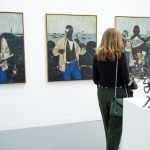
Everything you need to know about Frieze Art Fair 2018
Top and flops from the London's biggest art fair
October 8th, 2018
Another erratic Frieze week has ended in London, leaving the art world going back to its real life with lots to digest after broken record sales, i.e. Jenny Saville, and artist provocations, cc Banksy. During its XVI edition, Frieze London 2018 offered a lot of new material to catch up on for the art industry and its enthusiastic public.
Frieze is The art fair for Londoners, around which auctions, special openings, performances and – of course – parties satellite around London. Every year, Regent’s Park hosts its venues and thousands of people who come from all over the world to join in. With Frieze Masters, which exhibits ouvres up to the XXI century, Frieze Sculptures, with 25 outdoor works, and Frieze Art Fair, which exhibits today’s most significant artists, everyone’s taste is catered for and FOMO trigged. In case you couldn’t make it, here we will give you a brief summary of what happened during this edition.
The variety on offer was so large that treasures and trash happily coexisted under the same (plastic)roofs for a week. Among the Masters, it was impossible to not notice the greatness of artists such as Artemisia Gentileschi, Man Ray, Calder and other ‘classics’. Nevertheless, the attention was completely grabbed by the Spotlight choices, curated by Toby Kamps, where Annegret Soltau’s works undeniably stood up imposing the visitors to stop their path around the booths.
Meanwhile, just a few steps away, Frieze Art Fair inaugurated Social Works, celebrating eight women artists who fought against the political and social status quo during the ‘80s and ‘90s. Also during the last edition, the fair honored revolutionary women artists with Sex Work (in 2017), dedicated to feminist artists whose practice engaged with female sexuality. Hence, Social Work develops from the previous year following a very organic process that already creates high expectations about Frieze 2019. Although only two of the artists, Ipek Duben (Turkey) and Berni Searle (South Africa), do not belong to an American or British background, all eight of them (Mary Kelly, Faith Ringgold, Nancy Spero, Sonia Boyce, Hellen Chadwick and Tina Keane) had a substantial role not only as artists but also as educators for future generations. Most importantly, Social Works brings on the discussion between genders inequity in a context whose prominent and leading focus is economical.
Indeed, while established and blue-chip galleries, which cover the main area, do not provide any big surprise, the younger galleries are the ones that brighten up the fair.
In particular, Emalin’s choice to focus on the Canadian artist Athena Papadopoulos fascinates and intrigues the viewer. The juxtaposition between the “girly” materials used and the darker concepts discussed, as misogyny and anxiety, attracts the gaze of the public sparking questions and genuine curiosity for having a better understanding of the works. Definitely one of the most interesting corners of this edition of Frieze.
Courtesy of Emalin
Besides a few other galleries that favoured installations and sculptures, the majority of the works exhibited were paintings. Although provocative and, in some cases, absolutely outstanding – cc. Cinga Samson at the blank gallery – their presence was constant and charged the environment of a comforting predictability.

A predictability that was broken by Alex Baczynski-Jenkins, winner of the Frieze Artist Prize 2018. His practice engages with queer culture creating both a metaphorical and physical space to celebrate, embrace and discuss it through out his brilliant performances. Alex’s choreographic intervention was the quid that gave a wider breath to this year’s Frieze edition, captivating the public into this extremely important topic.





































.jpg)










.jpg)











































